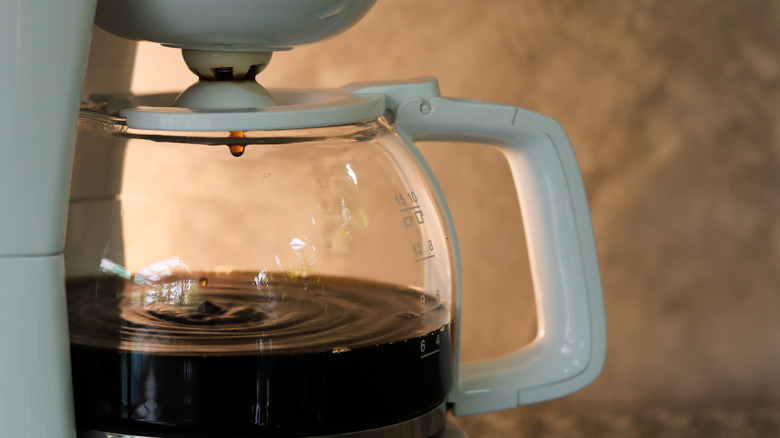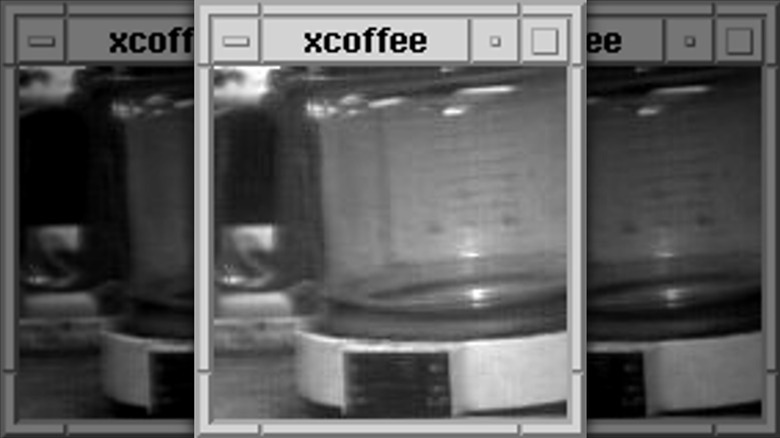The World's First Webcam Was Created To Babysit A Coffee Pot
In these modern days of remote work, Zoom meetings, and virtual hang-outs, it's almost impossible to imagine life without webcams. These handy cameras, which come pre-installed in just about every modern laptop, enable us to video chat with friends, family, and coworkers around the world, seeing their faces just as clearly as if they were in the same room with us. However, this now-ubiquitous tool is a relatively recent invention. And the very first webcam didn't have anything to do with communicating with people around the world at all. In fact, it didn't extend outside of a single building.
The world's very first webcam was thought up by highly intelligent, highly caffeinated researchers at the Computer Laboratory of the University of Cambridge in England in 1991. The group of weary computer scientists needed coffee to get through their long days of research, but the only coffee they had available to them was brewed in the Trojan Room, the main computer lab that was on a different floor from where many of them worked. "The coffee was only palatable at all if you got it fresh, so those who weren't in the same room as the machine had a significant disadvantage," Dr. Quentin Stafford-Fraser, one of the researchers and co-creators of the webcam, explained to PC Mag. So one afternoon, in the hopes of scoring fresher coffee, the tech-savvy researchers devised a method to monitor the Trojan Room coffee pot — the world's first webcam.
Yes, the first webcam was invented to watch a coffee pot
Desperate for a cup of hot coffee, Dr. Quentin Stafford-Fraser and his colleagues set up a spare video camera in the Trojan Room pointing at the coffee pot, and they connected it to a computer. From there, they rigged up a server program that captured images from the camera at three-second intervals. Stafford-Fraser then wrote a client software that connected to the server and displayed the images onto the Cambridge lab's local computer network.
The result was a small, grainy image of the coffee pot located inside the Trojan Room that the researchers could see in the corner of their computer screens, saving them the effort of walking all the way to the room to find an old, stale batch of coffee, or worse, no coffee at all. "The image was only updated about three times a minute, but that was fine because the pot filled rather slowly, and it was only greyscale, which was also fine, because so was the coffee," Stafford-Fraser joked to Open Culture.
The first webcam (and that Cambridge coffee pot) ran for 10 years
At first, the coffee pot cam ran on a closed network, viewable only to those on the same server as the Cambridge lab. However, on November 22, 1993, images from the camera made it onto the world wide web, thanks to another computer scientist named Dr. Martyn Johnson. Because Johnson wasn't on the same internal network as the researchers in the Cambridge lab, he couldn't see the coffee pot updates — that is, until he decided to write a script that copied the captured images when they were requested. The images were then uploaded onto the world wide web and accessible to anyone with internet access, making it the first ever real-life webcam.
The coffee pot camera was an international hit, with the BBC reporting that people from Japan wrote emails requesting that the Cambridge lab leave the light on at night so they could watch it during their daytime hours. However, the first webcam — along with the now-famous coffee pot — was finally switched off for good in 2001. "The software was becoming completely unmaintainable. Research software is not always of the highest quality, and we simply wanted to throw away the machines that were supporting this," Dr. Johnson explained to the BBC. The world's first webcam was finally put down after running for 10 years. As for the Trojan Room coffee pot, it received a second life once it was purchased by the German news magazine Der Spiegel at an auction for a sizable £3,350 sum.


